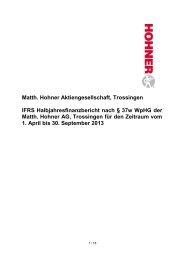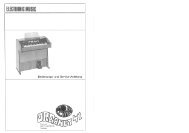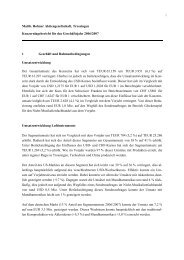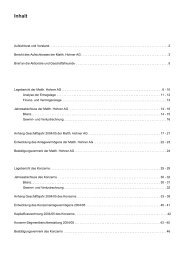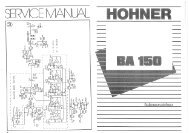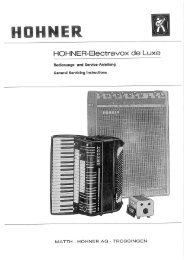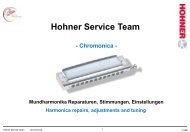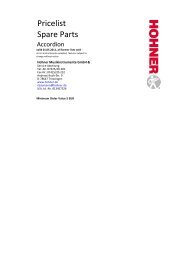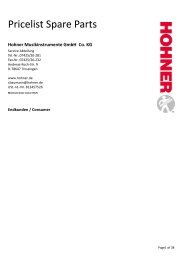Matth. Hohner AG
Matth. Hohner AG
Matth. Hohner AG
Create successful ePaper yourself
Turn your PDF publications into a flip-book with our unique Google optimized e-Paper software.
Notes to the Consolidated Financial Statements for Business Year 2010/2011<br />
Borrowing costs<br />
Borrowing costs that are directly attributable to the acquisition, construction or production of a qualifying<br />
asset form part of the cost of that asset and, therefore, should be capitalized. Other borrowing costs are<br />
recognized as an expense in the period in which they are incurred.<br />
Cash and cash equivalents<br />
Cash and cash equivalents include cash, bank balances, and short-term investments with original terms to<br />
maturity of less than three months. For cash flow statement purposes, this item contains the cash funds and<br />
short-term investments defined above as they are available and can be turned into cash at short notice.<br />
Non-current assets held for sale<br />
Non-current assets or disposal groups are classified as held for sale if its carrying amount will be recovered<br />
principally through a sale transaction rather than through continuing use. For this to be the case the sale<br />
of the asset or disposal group must be highly probable (more than 50 %) and the asset or disposal group<br />
must be available for sale in its present condition. For the sale to be highly probable the appropriate level of<br />
management must be committed to a plan to sell the asset. In addition, the sale should be expected to qualify<br />
for recognition as a completed sale within one year from the date of classification.<br />
A non-current asset (or disposal group) classified as held for sale is measured at the lower of its carrying<br />
amount and fair value less costs to sell. A non-current asset is not depreciated (or amortized) as long as it is<br />
classified as held for sale, but only impairment losses are recognized.<br />
Financial instruments and hedges<br />
Financial instruments as defined by IAS 39 are broken down into financial assets at fair value through profit or<br />
loss, loans and receivables, held-to-maturity investments or available-for-sale financial assets. Financial assets<br />
are carried at their fair values when recognized for the first time. In the case of financial investments which<br />
are not measured at fair value through profit or loss, any transaction costs that are directly attributable to the<br />
acquisition of the financial asset are also included.<br />
A retirement is only conducted, if the contractual right of an asset is running out or the asset value will be<br />
assigned.<br />
Financial liabilities ordinary constitute a claim on return in currency or another financial asset. The retirement<br />
of a financial liability will be only executed, if it is repaid, i.e. the obligation mentioned in the contact are<br />
fulfilled or repealed or run out.<br />
Regular way purchases and sales of financial assets are recognized as of the trading date, i.e., the date on<br />
which the Group entered into the obligation to purchase or sell the asset. A regular way purchase or sale is a<br />
purchase or sale of a financial asset under a contract whose terms require delivery of the asset within the time<br />
frame established generally by regulation or convention in the market place concerned<br />
The Group decides on the classification of its financial assets upon initial recognition and reviews allocation at<br />
the end of each business year if permissible and appropriate.<br />
For purposes of the IFRS 7’s instructions, financial assets will contain in the following categories:<br />
Financial Assets Available for Sale (AfS): Financial assets available for sale are mainly financial investments,<br />
thus shares in non-consolidated subsidiaries and investments. These financial assets are carried at fair value,<br />
derived from a stock-market price or a fair-market value, in case a realistic appraisal can be derived in an active<br />
market. Unrealized gains or losses are resulting in neither profit nor loss in an “available-for-sale-reserve” in<br />
equity. In the case of the disposal of financial instruments, any accumulated gains or losses from subsequent<br />
measurement, recorded in equity, are recognized at fair value in profit or loss. Since a fair value could<br />
neither be derived from comparable transactions in the reporting period, the financial assets were carried<br />
at amortized cost as best estimate for their fair value. In case of objective information, stating a permanent<br />
impairment of a financial asset, the impairment is recognized directly in profit or loss.<br />
Notes to the CoNsolidated FiNaNCial statemeNts Notes to the CoNsolidated FiNaNCial statemeNts<br />
75



